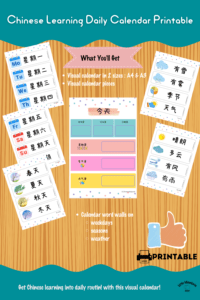
Home » Mandarin Chinese teaching resources » Chinese Visual Calendar for School or Home Use
Chinese Visual Calendar for School or Home Use

Daily calendars are great for kids to establish routines. Visual calendars are especially useful as they help kids use pictures, icons, and other fun visuals as a way to keep everyone staying on track in terms of the day’s expectations. Chinese visual calendar for kids serves as a tool not only showing the important information of the day, but also teaching kids Chinese language as part of a routine. It invites children to interact by providing important information of the day as a routine in Chinese. It is really useful for school and home use.

The layout of the Chinese visual calendar is quite simple: on the top, it says “TODAY”. However, it provides a lot of information about the day:
- Year
- Month
- Date
- Weekday
- Season
- Weather
By using them daily, it’s great for kids to establish a routine by telling the date, season and weather. It is also a good chance for them to practice the Chinese words for each of the topics.

How to Use the Calendar
The calendar can be used in several ways. No matter how you plan to use them, I would suggest having the printout laminated as you will use them over and over again.
- You could have it fastened on the cover of a notebook which your child uses on a daily basis. An activity at the beginning of the class can be filling the blanks of the calendar with the right pieces. >
- You could also hang the calendar on the wall and conduct “Tell Me About Today” activity with the whole class or with your kids at home together as part of the circle time. In addition to the calendar activity, they can continue talking a bit about what has happened to them the day before.

How to Use Velcro To Make The Calendar Interactive
Below is the direction I’ve given to teachers and parents how to use Velcro to make this Chinese visual calendar a great tool for class and home use:
- Print out the calendar and pages with calendar pieces. Laminate them. Then cut the laminated pieces out.
- On each spot of the calendar, stick a piece of Velcro using Velcro adhesive. Then stick the opposite side of Velcro on each of the calendar pieces.
- To use the calendar, stick the piece on the calendar spot by connecting the Velcro.
If you wonder what Velcro is, here is an example (this is an Amazon affiliate link).
Other Visual Schedules
There are some other visual schedules for kids that will help you to come up with a class schedule, laying out the activities of the day. Or you can use them to keep track of the household tasks that your child is responsible for. And, reward them for the good behavior and performance.
If You Like This Post, PIN IT!

Related Resources:
You May Also Be Interested:
- Chinese4kids Membership – a portal for busy Chinese teachers and parents
- Chinese learning flashcards Hive – a flashcards library that with regular additions of new quality Chinese learning flashcards
- Chinese learning worksheets collection – Also a part of Chinese4kids membership, this collection is for teachers and parents who want to have access to engaging worksheets and activity sheets created for kids learning Mandarin Chinese as an additional language
- Speak Chinese with Kids Course
- Chinese Vocabulary Made Easy Course
Recent Posts
Join Our Membership
Enroll to A Course
Buy An eBOOK
Our Posts
















